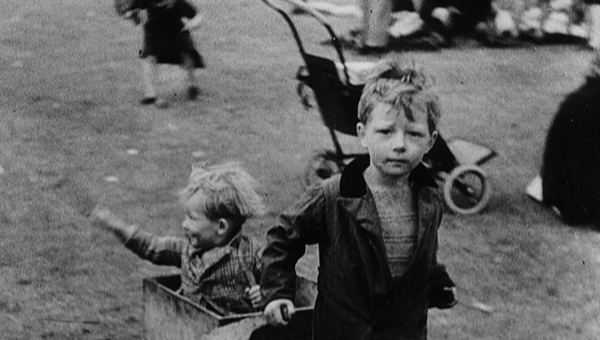
It’s not easy to be objective about a Ken Loach film; the audience tends to be either with him or against him, to paraphrase a certain US politician. THE SPIRIT OF ‘45 is a beautiful and artful meeting of archive film clips complemented by gorgeous, crisply photographed interview sections, which inform the clips. These have been skillfully crafted into a clarion call to rekindle the pioneering post-World War II spirit that forged our modern welfare state, including (and in this case especially) the establishment of the NHS in 1948, which Loach believes is now under imminent threat of destruction.
Loach’s interviewees are erudite, lively pensioners who share stories about tough lives in the 1930s and ‘40s, some of which are shocking: dire living conditions, overcrowding, bedbugs, deaths caused by lack of money to pay for medical treatment. We discover that before the NHS, shortsighted people with no money could not afford glasses. Imagine that. Suddenly NHS glasses arrived and hey presto – you could see! For free!
THE SPIRIT OF ‘45 describes a world changed in every way by World War II. Pre-war footage shows snotty kids playing in the street; mothers forever cleaning trying to control vermin; rats scuttling by a pram in a hallway. Spool forward to the end of the war in Europe with clips of joyous celebrations on VE Day, 8th May 1945: cities festooned with ticker-tape; dancing in the streets; a newly-returned Dad running down the street to rejoin his wife and kids; hugs and kisses at the docks as soldiers come home after years away. In a few months Churchill’s administration was shoved aside in a landslide Labour victory under Clement Atlee.
[Loach’s] work is highly personal but, as ever, he doesn’t disguise his intentions
Nationalising the utilities was integral to the spirit of the time, which Loach uses as a filmic bridge to the 1980s and the social consequences of Margaret Thatcher’s election in 1979. Loach argues that this is when the spirit of ‘45 was crushed under the heel of history, with privatisation of the utilities, anti-union legislation and growing dependence on market forces.
The final scene repeats clips from the 1945 section, but in Technicolor. Colour film from this period is very powerful, bringing people out of memory and into our own time. One of the most memorable switches to colour is of two young women, who we’d seen earlier in the b/w section. In colour their pouting and preening to camera seems to embody the boldness and hope of the age.
SPIRIT is as scathing about the Labour Party as it is about the Conservatives: Loach believes that neither has protected the ‘working class’ and that a new people’s alliance is needed. His work is highly personal but, as ever, he doesn’t disguise his intentions. It’s a beautiful, emotional film, enlivened by real stories of both deprivation and of optimism, and although the debate about its political bias rages, THE SPIRIT OF ‘45 shines a welcome light on our recent history.
httpvh://youtu.be/_c86Gwsb5LY


This is indeed a timely film. Our wonderful NHS is being allowed to crumble under the hands of our failing government.
Let’s hope it kickstarts people’s memory of what we’re in danger of losing
What a great review – definitely has inspired me to see the film and take my teenagers – and lets use the lessons of history to inform a better future. 🙂
Thanks Helen, that’s a great plan, hope they enjoy the film, or at least want to talk about the issues Ken’s raising.
Some reviews tell you so much about a film that you reckon that you might skip watching it, others commend or criticize actors or directors without really making clear what they did right / wrong : this is a documentary, of course, but it is a spot-on account of why this film and the period that Loach wants us to consider matter. Thank you !
Thanks very much! It’s one of those films that worms its little way into your mind, I love that